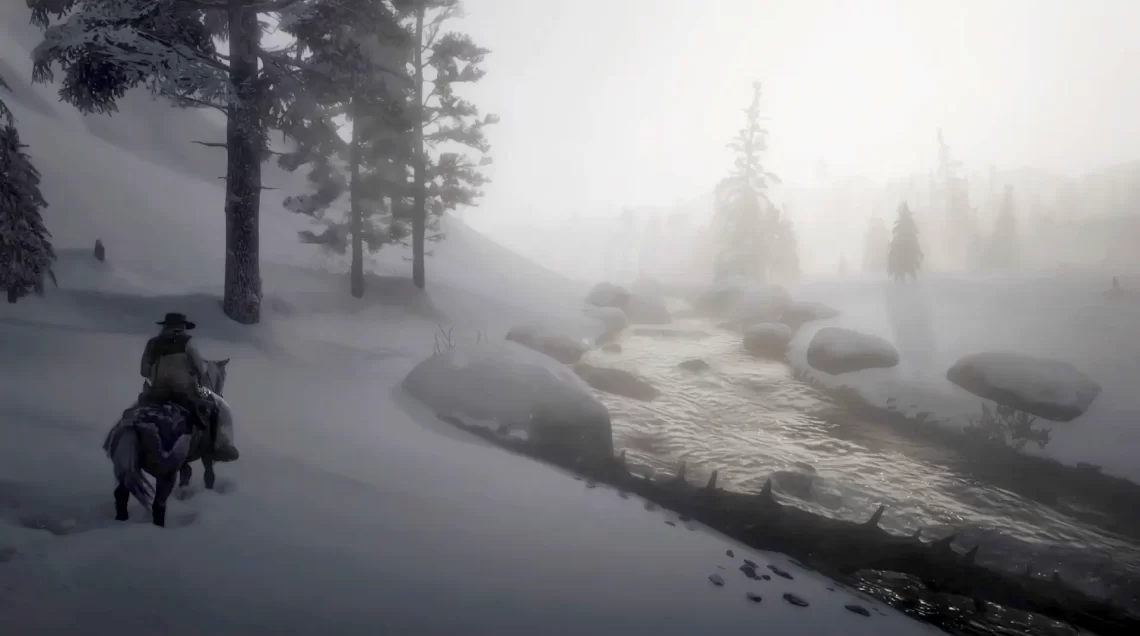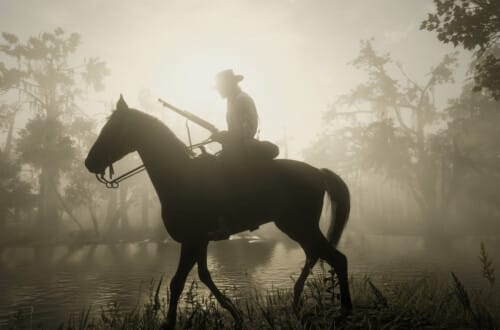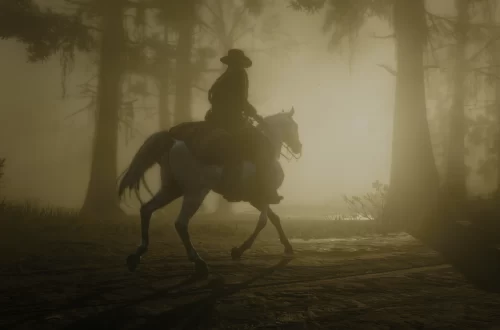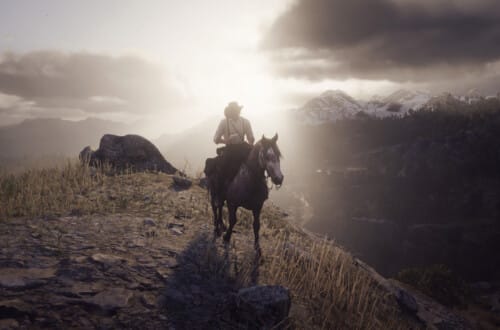Themes and locations in RDR2 inspired by John Williams’s classic Western novel Butcher’s Crossing.
All articles on this site feature detailed discussion of literary allusions in Red Dead Redemption 2, and as such contain unmarked major and minor spoilers for the game, and occasionally the eventual fates of some characters in Red Dead Redemption. Read at your own risk.
Butcher’s Crossing is an 1960 novel by John Williams about a young man named (hilariously) William Andrews, who leaves Harvard in the 1870s to go West and experience the parts of the country untouched by European colonizers. In part, he’s inspired to do so by Ralph Waldo Emerson, the most prominent figure of the Transcendentalist movement. Another leader in the literary movement, Henry David Thoreau, is part of the basis for the character Evelyn Miller.
Although Evelyn is primarily named for Joaquin Miller, his last name is one of RDR2‘s double allusions: “Miller” is also the name of one of Butcher’s Crossing‘s main characters. Williams’s Miller, with Chris Evans, Milton’s Satan, and Lord Byron, is one of the most important figures in the creation of Dutch Van der Linde. (No wonder Dutch worships Evelyn!)
Andrews meets Miller in the town of Butcher’s Crossing, where he first introduces himself to J.D. McDonald, an old acquaintance of his father’s. McDonald offers him a job, but Andrews declines, telling him, “I came out here to see as much of the country as I can” (Williams 22). McDonald reluctantly suggests that Andrews talk to Miller, whom he describes as the best of a bad lot.
When they meet, Miller tells Andrews that he’s dreamed of a huge buffalo hunt for years, ever since he found a valley where the animals congregate that no one else knows about. People don’t believe that he could find this valley again, or that the animals will still be there, or that the quality of their hides will be as good as he claims. Andrews — naive, romantic, a dreamer in search of something — is willing to take the chance. He agrees to fund the expedition on the condition that he’s allowed to come along and get the life experience he so badly desires. Miller stresses that despite the fact that Will is putting up all the money, “it would still be my hunt” (35). Like Dutch, he’s a petty king. Miller quickly organizes a team: his friend Charley Hoge to drive the wagon and manage the oxen, and Fred Schneider to skin the buffalo Miller kills.
The trip gets off to a rocky start. The land has changed — or Miller doesn’t remember it as well as he thinks — and the men nearly die of dehydration. But Miller is a highly competent survivalist in skill if not judgment; he gets them lost, but he also knows exactly what to do to save themselves and their animals. Finally, they find the valley. As promised, it’s full of buffalo with thick, high-quality hides. Miller becomes possessed of a monomania to kill every last buffalo there: thousands of them. The four men spend weeks in the once-paradisaical valley, Miller mowing the buffalo down with his rifle, Schneider and Andrews skinning the animals and leaving the carcasses to rot in a riot of waste. Weeks pass this way. Fred wants to leave as planned with the bounty they’ve reaped; Miller refuses. He wants to kill all of the buffalo, every last one.
When he’s nearly completed his slaughter, a blizzard blows in. The group only survives by huddling inside hastily-stitched shrouds of buffalo skins for days. When the blizzard finally clears, the passes are snowed under. They’re trapped in the valley all winter. This event is one influence on RDR2‘s Colter chapter.
Months later, when they can finally leave, they load their wagon with as many hides as they can. They leave the rest to come back for later. On the trip, they have to ford a river swollen with spring melt. (The newspaper article “Blizzard Aftermath in Grizzlies” discusses the dangers of rivers bursting their banks and is an allusion to the novel.) As they cross, a log comes sailing down the river, hits Schneider and his horse, and kills them both. Moments later, it rams into the wagon, taking the oxen and all the skins with it.
Miller only cares about the hides. Dutch, similarly, can be astonishingly callous about the deaths of the people who follow him: Eagle Flies, Susan Grimshaw, and Lenny Summers, for instance.
Back in Butcher’s Crossing, the town seems subtly changed, off somehow. J. D. McDonald, who’s supposed to buy the hides, isn’t in his office. When Will and Miller finally track him down, he tells them that the market has collapsed. He can’t buy the hides; he’s ruined. If they had come back on time — if Miller hadn’t been so obsessed with killing every last buffalo — they would have made their money. Miller, like Dutch, has fallen out of pace with the rest of the world and made the wrong plays. He thought he’d make a fortune; instead, he lost everything.
During their confrontation, McDonald asks Miller, “You trapped beaver once, didn’t you? When they stopped wearing beaver hats you couldn’t give the skins away. Well, it seems everyone that wants one has a buffalo robe; and nobody wants any more” (247). Miller, like Dutch, could have learned from the past, but both men find themselves unable, or perhaps unwilling, to do so. They can’t adapt to their changing circumstances, even though their own actions led to those very changes. Buffalo were over-hunted, so Miller had to go to the middle of nowhere to find animals with high-quality hides. Miller was one of the people doing the over-hunting, and rather than trying to preserve what was left, he wanted to destroy it utterly.
In a parallel manner, the Pinkertons exist partly as a response to outlaws like Dutch; they keep coming after the gang because Dutch keeps robbing banks and trains and killing people. At the same time, Dutch and Miller are both caught in the wheels of rapid change. They’re only part of the picture. But they’re sure as hell making things worse.
History, Butcher’s Crossing, and RDR2
One of the things RDR2 is best at is environmental storytelling. Two men dead and bloody in a cabin, a gold nugget on the table: Man A showed Man B the nugget he found. Man B hit him with a hammer so he could steal Man A’s gold. Man A struck him back, killing him, then succumbed to his wounds.
But the scenes aren’t always this clear. They can be strange or confusing. And sometimes, their mysteries are hidden in plain sight: what looks ordinary, unremarkable, holds hidden meaning.
Such is the case with the Warped Tree and Larned Sod. The house is inspired by a scene from Butcher’s Crossing: on their journey to the valley, “the group passed a small hut with a sod roof. The hut was set on the open plain; behind it a small plot of ground had been cleared once, but now it was going back to the yellow-green grass that covered the land. A broken wagon wheel lay near the front entrance, and a heavy wooden plow was rotting beside it” (Williams 69). Larned Sod is a sod-roofed house “set on the open plain” and has a broken wagon wheel near the front door.

But it gets deeper!
The house is another of the game’s double allusions. Larned Sod is located in an area that represents the Great Plains1 of the United States. When settlers began colonizing the plains, there was little lumber to hand, so they had to use what they could to build shelter: sod. Those colonizers included the U.S. Army, who constructed Fort Larned out of sod in 1860. The fort was named “in honor of Col. Benjamin F. Larned, paymaster of the United States army” (Unrau). Larned Sod is named after the fort in turn.
But it gets even deeper!
The date above may have caught your eye: 1860 was the year before the Civil War began. In 1861, the territory where Fort Larned was located was admitted to the Union as a state: Kansas. That’s where the town of Butcher’s Crossing is.
Kansas’s entry into the United States was particularly vexed: violence over the question of whether the state would allow people to enslave others led to the area being called “Bleeding Kansas.” Therefore, although most major battles took place East of the state, Kansas was a microcosm of the Civil War.
The man who lives at Larned Sod sometimes climbs the hill by his house. At the top, a dead tree, and underneath it, a grave marked by a plain cross. The map is full of dead trees and graves, but this tree — the Warped Tree — is a Point of Interest. That’s because it’s an allusion to this famous photograph taken during the Civil War.

Antietam is one of the most well-known battles of the Civil War.

To drive it home, the branch directly above the grave is a spawn point for a bald eagle, the national symbol of the United States.

The house, grave, and tree appear to be a simple scene, but are a tapestry of allusions.
More Allusions to Butcher’s Crossing in RDR2
Themes
Man vs nature. The beauty of nature and man’s wanton destruction of it are major themes of both Butcher’s Crossing and RDR2.
Left behind. Arthur sometimes says that “they don’t want folk like us no more” (in “A Quiet Time,” for instance). In Butcher’s Crossing, McDonald tells Miller, “the hide business is finished. For good . . . Just like you’re finished, Miller. And your kind” (247) (which is, incidentally, very much the cadence of RDR2‘s dialog). RDR2‘s outlaws and Butcher’s Crossing‘s hunters are both unable to go on the way they have been, largely because of the effects that they themselves have had on the world around them.
Motifs & Symbols
Buffalo. Buffalo carcasses are a symbol of the dying West-as-an-ideal in both game and novel. In Charles Smith’s Companion Activity, poachers slaughter buffalo and leave them to rot. One of the hunters says they were paid to do it to make Native Americans look bad, which is ahistorical. Killing buffalo was committed as a deliberately anti-Native American act, but it was done to starve people — not to tarnish their image (Dunbar-Ortiz). Charles talks about using every part of the buffalo, which Miller also mentions in the novel (Williams 81).
Names
J. D. McKnight. This economist is described in the RDR2 newspaper article “Banks Worry of Crash.” He’s also featured on a cigarette card and has a business in Saint Denis. His name alludes to J. D. McDonald. “Knight” is a suitable replacement for “Donald,” given the allusions to Arthurian legend. The name is a typical Rockstarian irony: knights are supposed to be honorable; capitalists are anything but.
Characters
Reverend Swanson and the Mad Preacher. Charley Hoge is a devout Christian and an alcoholic. He likely had an influence on Reverend Swanson’s character, as well as the Mad Preacher’s. When Schneider is killed in the river, Charley has a psychological episode and starts babbling about Fred’s death being the Lord’s will. The Mad Preacher is always found in rivers. In his last encounter with Arthur, the Mad Preacher says, “I asked for a message and he gave me the whole world.” Arthur asks, “Wasn’t that enough?” The Preacher answers, “No … it wasn’t enough. It wasn’t enough at all. That’s the problem. I’m so … I’m so greedy.” This speaks to the novel’s condemnation of rapacious acquisition.
“Unfinished Letter.” This document can be looted from a corpse that two men, evidently having murdered the man, dump in the open pit just outside of Armadillo. The letter writer is based on William Andrews. The letter talks about dropping out of Harvard to “find a true America,” which is exactly what William tries to do.
Places
Butcher Creek. RDR2‘s Butcher Creek was originally named Butcher’s Creek. Remnants of the possessive form show up in dialog and Arthur’s journal (“The Wisdom of the Elders I”; entry after “The Wisdom of the Elders II”). In the novel, McDonald’s office is “just out of town, by the creek” (241). An RDR2 newspaper article, “A Sickness Spreads,” says that Butcher Creek used to be a fur-trading town (like Butcher’s Crossing); one of the buildings there is piled with furs and animal skeletons. Also like Butcher’s Crossing, Butcher Creek used to be far more lively, but fell into decline.
Skeletons. This scene, found not far from Susan Grimshaw’s grave, is an allusion to the novel. Three of the skeletons are in the main part of the lean-to, with the fourth in a separate area off to the side. When the blizzard rolls in, Fred, furious with Miller, sets himself up apart from Miller, Charley, and Andrews.

One of the skeletons holds a cross and is missing its right arm; Charley Hoge is a devout Christian and is missing his right arm (although most of this skeleton is missing, not just the arm). After the initial blizzard passes, the Butcher’s Crossing hunting group builds a lean-to like this one. The RDR2 scene includes a wagon wheel, possibly alluding to the climactic wagon accident. The scene is near where the railroad tracks are being built; the railroad is supposed to come through Butcher’s Crossing but is rerouted, which is what leads to the decline of the town.

Bard’s Crossing. In addition to alluding to Orpheus’s journey from the underworld, the name of the bridge alludes to the novel.
Events
Fire. The novel’s climax occurs when an infuriated Miller sets all the hides piled at McDonald’s office on fire. The gang’s belongings are also set on fire in “Red Dead Redemption,” creating a similarly hellish and chaotic landscape.
Miscellaneous
Bierstadt. The cover of the 2007 New York Review Books edition — at the time the game was written, the only one in print — features a painting by Albert Bierstadt, upon whose work Arthur’s honor visions are based.
Red Dead Redemption. Rockstar’s developers may have had the novel in mind in the first game in the series, when they created the tasteless achievement “Manifest Destiny” for killing every buffalo.
Double meanings. “Butcher’s Crossing” has at least two meanings: the name of the town, and the accident in which Fred — the skinner — loses his life. One could also argue that Miller is the real butcher, and the crossing in which Fred dies is his. The title also alludes to Andrews, who assisted Fred in skinning the animals, “crossing” from youth to adulthood. While the shifting significance can’t be alluded to, per se, it’s interesting that RDR2 takes a similar approach in building meaning, particularly with allusions: the writers layer, weave, and nest the threads of their chosen texts into the game.
New essays are published Wednesdays at 1 p.m. E.T./10 a.m. P.T. Follow me on Bluesky, Twitter, or Tumblr for updates.
New here? Visit the Table of Contents to read the essays in order.
Sharing the site is deeply appreciated!
- Yes, there’s also a Great Plains in the “original” part of the map. RDR2‘s map isn’t shaped like the actual North American continent, so naturally, the representation isn’t 1:1. Areas are split up, stretched out, shuffled around, compacted, etc. ↩︎
Bibliography
Expand to view sources.
- “Bleeding Kansas.” Kansapedia, Kansas Historical Society, Sept. 2016, https://www.kansashistory.gov/kansapedia/bleeding-kansas/15145.
- “Building a Sod House: How Early Settlers Made Shelter on the Prairie.” Laura Ingalls Wilder & Little House Books, https://laurasprairiehouse.com/building-a-sod-house-how-early-settlers-made-shelter-on-the-prairie/.
- Dunbar-Ortiz, Roxanne. An Indigenous Peoples’ History of the United States. Beacon Press, 2014.
- Gardner, Alexander. Antietam, Maryland. A lone grave. Library of Congress, Sept. 1862, https://www.loc.gov/resource/cwpb.01109/.
- Houser, Dan, et al. “Red Dead Redemption II.” Rockstar Games, 2018.
- Unrau, William E. “The Story of Fort Larned.” Kansas History: A Journal of the Central Plains, Kansas Historical Society, 1957, https://www.kansashistory.gov/p/kansas-historical-quarterly-the-story-of-fort-larned/13139.
- “When Kansas Became a State.” Transcribed by Jim Scheetz. The Kansas Historical Quarterly, Kansas Historical Society, 1961, https://www.kansashistory.gov/p/when-kansas-became-a-state/13159.
- Williams, John. Butcher’s Crossing. New York Review Books, 2007.





